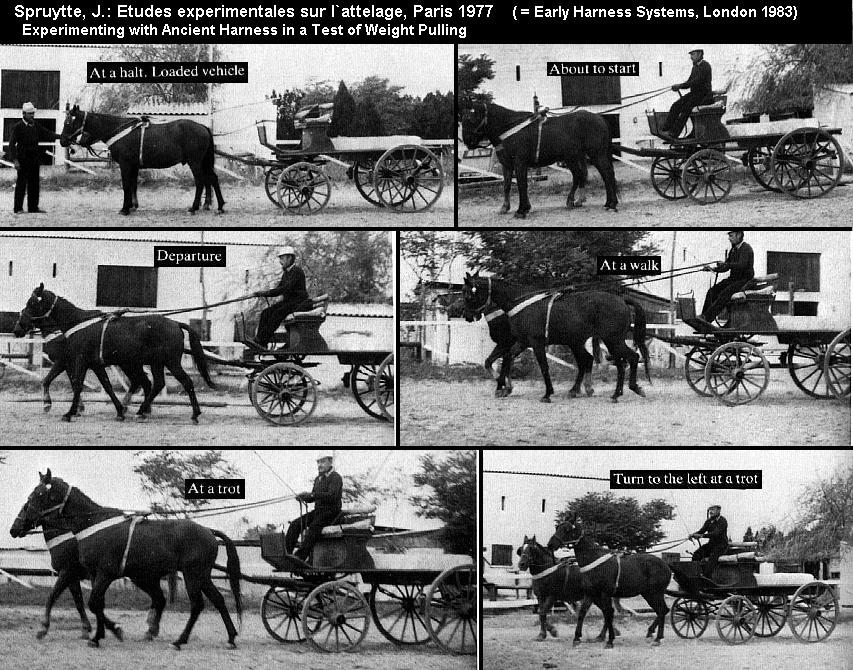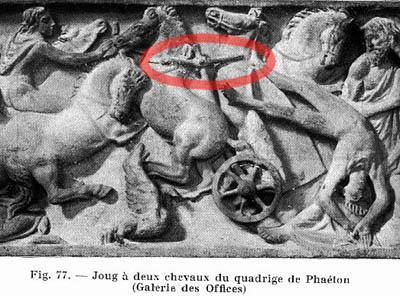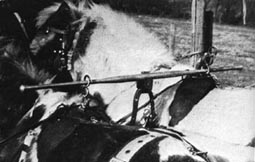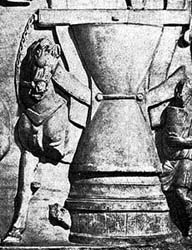The dorsal yoke consisted of a forked device, probably made of metal by Roman times, which was placed on the horse or mule directly behind the withers and held in place by a surcingle. A chest strap was fastened to rings on either side of the yoke to hold the harness in place. Archaeological excavations at Wange(1989/90)1 have uncovered a metal piece which was used in harnessing horses.
Fig. 2: The Wange yoke before reconstruction.2
Fig. 3: A sketch of the reconstructed Wange Yoke3
Fig. 4: A sketch of the reconstructed Wange yoke on a horse.4
This find and subsequent reconstruction of a dorsal yoke serves to confirm the gross error made by Lefebvre des Noëttes.
But even before this important find, scholars were suspicious of Lefebvre des Noëttes reconstruction of harness. In fact in 1977 J. Spruytte, did a series of experiments on various types of equine traction systems covering, among others, Ancient Egypt, Ancient Greece and Ancient Rome. He was aided in his reconstruction of the harnesses by experts in the field most notably M. L. Littauer. His experiment demonstrated conclusively the errors in Lefebvre des Noëttes' harness reconstruction (See Figure 5 below)5.

Fig. 5: J. Spruytte's experiment with Roman harness systems done
in 1977. Note the difference between that and the one done in 1910
The dorsal yoke was used by both single horses and teams. When teams were used there was a bar, probably made of wood, which was tied to the yoke of both horses and to the center pole. (See Figure 6 Below).
Fig. 6: Spruytte's Harness Showing Wooden Bar6
In the picture below we can actually see this bar in several carvings depicting chariot wrecks. The connecting bar is circled in red.

Fig. 7: Chariot Wreck7
The bar helped to keep the horses moving together as a team. The traction exerted by the horse pulling was on the chest of the animal. "Moreover, a paired horse team under a yoke connected to the draught pole of a two-wheeled vehicle is not antique in the historical sense and did not disappear with antiquity"8.If the dorsal yoke was used singularly it would have been used with a non-existing linking bar such as that shown in Fig. 4 for the Wange yoke. Actually the dorsal yoke has survived, virtually unchanged into the modern era where it appears as the modern curricle harness (See Fig. 8).

Fig. 8: Modern Curricle Harness9
"The curricle bar is nothing more than a dorsal yoke, assuring the support of the vehicle"10
The traction point of the dorsal yoke was on the chest of the animal. Although Lefebvre des Noëttes11 insisted that the chest strap rode up putting pressure on the wind-pipe causing the animal to strangle, this was because Commandant placed the yoke on top of the withers. When the yoke is correctly placed, behind the withers, the chest strap does not ride up12.
There is no evidence of the chest strap riding up this in either the contemporary literature of the period, or various pictorial efforts. Indeed Apuleius in the Metamorphoses, speaks of the sores rubbed on horses' chests by the strap14.It may be noted that the breast collars, cut to fit the horses, do not rise towards the neck. The horses are not at all inconvenienced and raise neither head nor neck. The start, walk and trot are performed under the same conditions as with modern harness.13
On the subject of a breaststrap it is interesting to note that just as in 1967 we learned that the Romans had a fixed tree saddle15, we learned in 1987 that a form of breastplate was used in the Roman cavalry which held the chest strap in place by a piece of leather connecting to the front of the strap and then passed between the horses' front legs and attached to the girth16. With few modifications this piece of Roman cavalry harness has survived today as the hunting breastplate. The purpose of this device was to prevent the fixed-tree saddle from sliding back. To prevent it from sliding forward a breeching was used which resembles modern harness breeching to an amazing extent17.
If the Romans had all this technology available to use in their riding equipment, the question must be asked if some of this did not transfer over into the areas of transportation harness. It will need further archaeological work to resolve this issue. But it should be obvious to the most casual observer that preconceptions about Roman saddlery and harnessing have fallen by the wayside as a result of research and new discoveries. One has only to consider the speeds of chariots to realize that the Roman harness posed no barrier to the animal's breathing. These chariot races varied in distance from 4 miles to 7 miles , at a gallop, depending on the nearness of the team to the spina18 and it is absurd to believe that horses had their breathing impaired due to inadequate harness. Surely Pelagonius in his Ars Veterinaria would have commented on this fact as he did on so many other ailments of the horse at the track. I also have no doubt that satirists such as Juvenal or Persius would have mentioned the problem, since Juvenal was not loath to discuss the poor treatment of horses in other areas of life19.
Indeed if we look at various reliefs of animals with the dorsal yoke, the placement of the breast strap is obvious and even in the most dire circumstances there is no sign that the breast strap moved up. Indeed there is every evidence that it remained in place (see Figure 9). Notice how the breast strap is pulled down almost to a "V" in front as if there were an additional strap between the legs.

Fig. 9: Horse at grinding wheel20
Alas the break in the relief prevents any such conclusion to be drawn. Unfortunately the pictorial evidence we have probably does not include every strap on the harness. Indeed to correctly see this attachment a frontal view of the animal is required. It is only due to archaeology that we know of the existence of the breeching and breast strap for riding. The find at Wange demonstrates that the dorsal yoke was placed behind the withers, not on top as Lefebvre des Noëttes had believed. So the fact that we do not see a strap running from the chest strap between the legs to the girth it in harness animals does not mean that it did not exist. After all it was long believed that the Romans had no fixed tree saddle but rode on a pad.
- Lodewijckx & Wouters, pp. 66
- Ibid., p. 61
- Ibid., p. 63.
- Ibid., p. 64.
- Spruytte, pp. 98 - 104
- Ibid., p. 100
- Lefebvre des Noëttes, II, 1931 - Fig. 77.
- Spruytte, p. 15
- Ibid., p. 72
- Ibid., p. 15 Fn. 10
- Lefebvre des Noëttes. 1924, pp. 85-86.
- Spruytte, p.99 - With the discovery of the Wange yoke, it is interesting to note that the attachments of the chest band to the yoke itself, now appear to be lower than that demonstrated by Spruytte in 1977.
- Ibid.
- Apuleius, p. 180
- Hyland, p. 131
- Ibid., p.131. This was the result of a reconstruction from a find of leather saddle housing and component parts. See Connolly
- Ibid., pp. 135-136
- Ibid., p. 204
- Juvenal, Satires, VIII
- Lefebvre des Noëttes, II, 1931 - Fig. 74